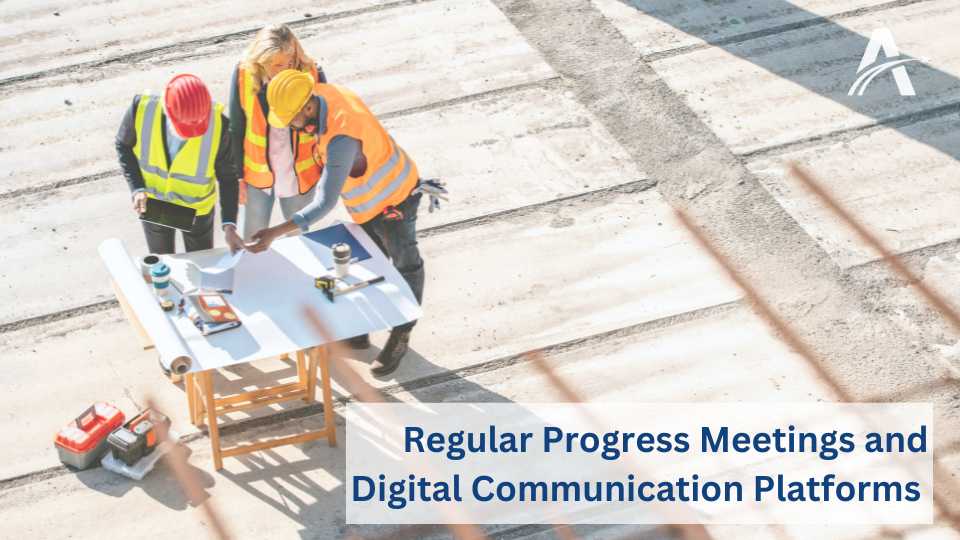Construction Planning: Best Tools and Methods for Communicating Progress to Clients
Source: internet

Effectively communicating project progress is essential for maintaining transparency and trust with clients.
1. Define the scope and goals
The first step in managing expectations is to clearly define the scope and goals of construction project, ensuring they align with your client’s vision and needs.
Document the project objectives, deliverables, budget, timeline, quality standards, and risks, and obtain formal approval from your client. This documentation will serve as the foundation for your communication plan and help prevent scope creep and misunderstandings throughout the project.
2. Choose the right communication tools
The next step is to select the most suitable communication tools for your project and ensure they are used effectively and consistently. Depending on the size, complexity, and nature of your project, different tools may serve distinct purposes:
- Email: Best for formal and official communication, such as contracts, change requests, and important documentation.
- Phone Calls: Ideal for quick, informal updates, feedback, or clarifications that require immediate attention.
- Video Conferencing: Useful for meetings, presentations, and discussions, especially when working with remote teams or clients in different time zones.
Besides, the best Tools and Methods for Communicating Progress to Clients in Construction:
Dashboards and Reports: Provide an at-a-glance summary of key performance indicators, such as schedule, budget, quality, and risks, ensuring stakeholders are aligned with the project’s status.
By choosing and combining the right tools, you can ensure efficient communication, enhance collaboration, and maintain transparency throughout the project.
- BIM dashboards or project management software (e.g., Bimplus, Microsoft Power BI, Procore, or Autodesk BIM 360) provide real-time visual reports of key metrics like budget, schedule, and task completion.
- Automated reporting tools can generate regular updates, reducing manual effort and ensuring clients always have up-to-date information.

3. Communicate frequently and transparently
The third step is to communicate frequently and transparently with your client, ensuring they remain informed and engaged throughout the project. Establish a regular communication schedule and adhere to it consistently.
Proactive communication is essential — don’t wait for the client to ask for updates. Instead:
- Report on achievements, challenges, and next steps to keep them aware of progress.
- Highlight any deviations or changes from the original plan, along with their potential impact.
- Solicit feedback and input to align with the client’s evolving expectations.
- Acknowledge their concerns and demonstrate that their input is valued and acted upon.
This open and structured communication fosters trust, strengthens collaboration, and minimizes the risk of misunderstandings.
Regular Progress Meetings and Digital Communication Platforms
Schedule regular progress meetings (weekly or bi-weekly) with clients, either in person or through video conferencing platforms like Microsoft Teams or Zoom, Google Meet…
Use collaboration tools such as Bimplus, Asana, or Slack to keep communication continuous and share updates, timelines, and decisions in one place.

Client-Specific Reports and Deliverables
Customize reports based on the client’s needs, including cost forecasts, milestone achievements, and resource tracking.
Use custom templates for monthly or quarterly reports that include KPIs, financial updates, and risk assessments to keep clients fully informed.
Real-Time Issue Tracking and Resolution Tools
Platforms like Procore, Bimplus, or PlanGrid enable clients to monitor issues in real-time, ensuring transparency in handling risks, changes, and delays.
By providing access to issue logs and resolutions, clients feel more involved and confident in the project’s management.
By using a combination of these tools and methods, construction teams can maintain open communication, foster trust, and ensure that clients are kept well-informed throughout the project’s lifecycle. This not only builds stronger relationships but also reduces misunderstandings, ensuring smoother project delivery
4. Manage changes and issues
The fourth step is to manage changes and issues professionally and respectfully as they arise during the project. Having a clear, agreed-upon change management process is essential. Follow this process whenever you or your client requests or proposes changes to the scope, budget, timeline, or quality of the project.
In addition, implement a risk management plan to identify, assess, and mitigate any potential or actual risks that could affect the project.
When changes or issues occur:
- Communicate promptly with your client, explaining the impact and implications of the situation.
- Propose solutions and alternatives to address the issue or accommodate the change.
- Seek the client’s approval and support to ensure alignment moving forward.
Proactive management of changes and risks fosters trust, maintains project momentum, and ensures smoother collaboration.
5. Celebrate successes and learn from failures
The fifth step is to celebrate successes and learn from failures with your client, while recognizing their contribution and feedback.
- Acknowledge and reward the achievements of both your team and your client, highlighting milestones reached and efforts made.
- Share positive testimonials and reviews to reinforce the value of the partnership and build goodwill for future collaborations.
- Conduct a post-project evaluation to reflect on what went well and what could be improved.
- Document and share lessons learned and best practices to ensure continuous improvement across future projects.
By taking time to appreciate successes and analyze areas for growth, you strengthen relationships, foster collaboration, and set the stage for even more effective projects in the future.
6. Build long-term relationships
The sixth and final step is to build long-term relationships with your client and maintain contact and trust after the project’s completion.
- Follow up with your client to thank them for their business and collaboration, reinforcing the positive experience.
- Provide ongoing support and maintenance, addressing any issues or questions that arise promptly.
- Seek referrals and recommendations, offering incentives or discounts for repeat or new business to encourage continued engagement.
- Stay connected by updating them on your latest news, offers, and projects, keeping your services top of mind.
By fostering lasting relationships and maintaining consistent communication, you build trust, promote loyalty, and create opportunities for future collaboration.
More Posts

Hardware and Software Requirements for ALLPLAN 2026
ALLPLAN System Requirements

Why Construction data should fit your project like a custom blueprint?
In an ideal world, ours would be an industry that ran on precision and fine margins but, as we all know, there is nothing precise

What is Design for Manufacturing and Assembly (DFMA)?
Source: Internet Design for Manufacturing and Assembly (DFMA) is a product design approach that focuses on simplifying the manufacturing and assembly processes to reduce production

